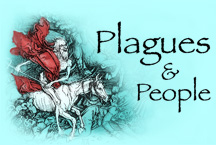
Infectious and Epidemic Disease in History
Department of History
University of California, Irvine
Instructor: Dr. Barbara J. Becker

Department of History
University of California, Irvine
Instructor: Dr. Barbara J. Becker
Supplementary readings for Week 2's lectures include excerpts from:
After the plague of Justinian subsided in 544, population centers in the Near East, North Africa and Europe were visited repeatedly by epidemic disease. Major ports like Constantinople, Antioch, and Marseilles were particularly hard hit. In his epic History of the Franks, Gregory, revered bishop of Tours, recorded the deadly devastations of 571 and 588 as well as the celestial signs that foretold their coming. The waves of plague dwindled by the mid-8th century. Another six hundred years passed, and once-vivid tales of those grim events gradually faded from the collective memory. In the mid-14th century, another great pestilence threatened to annihilate the "whole human race." Once again, civic and religious leaders of the day recorded the plague's local and global effects. Scholars and artisans joined them in seeking some sort of meaning in the widespread death and destruction it caused. How do these accounts compare with those of Thucydides, Plutarch, and Procopius? How do fourteenth century explanations of disease compare with those of Hippocrates? |
 |
| Go to: |
|